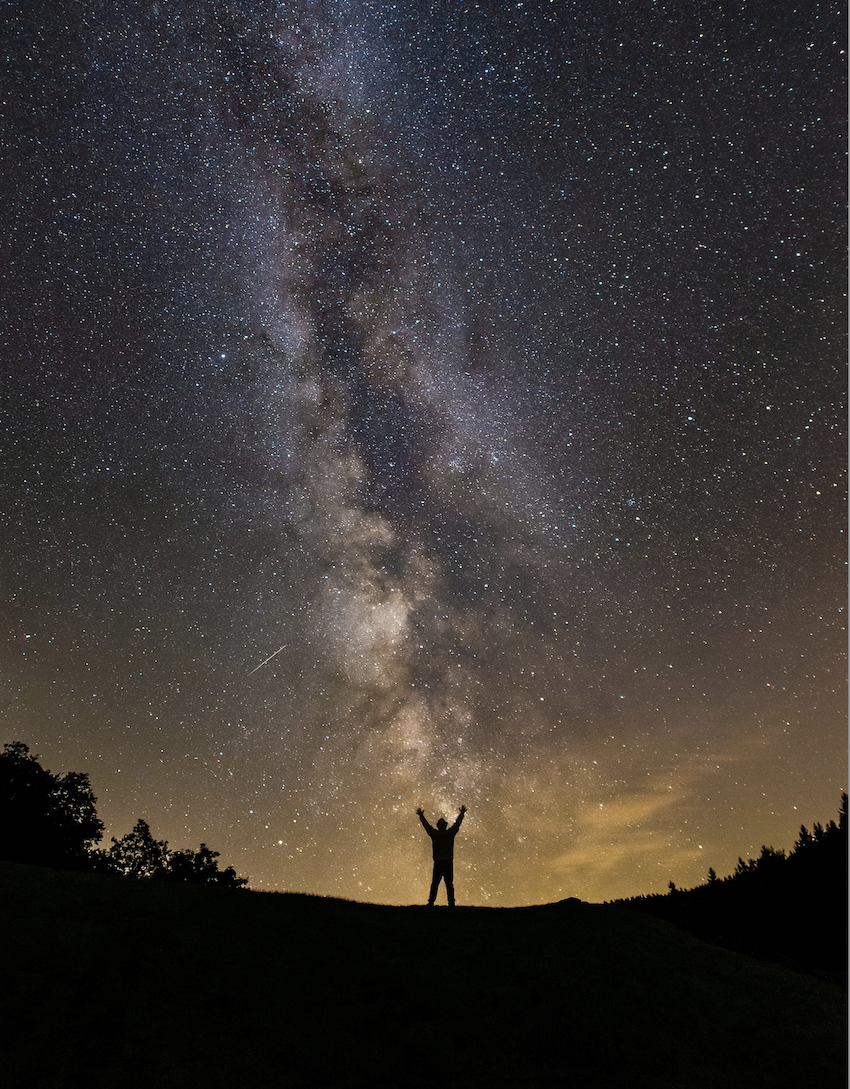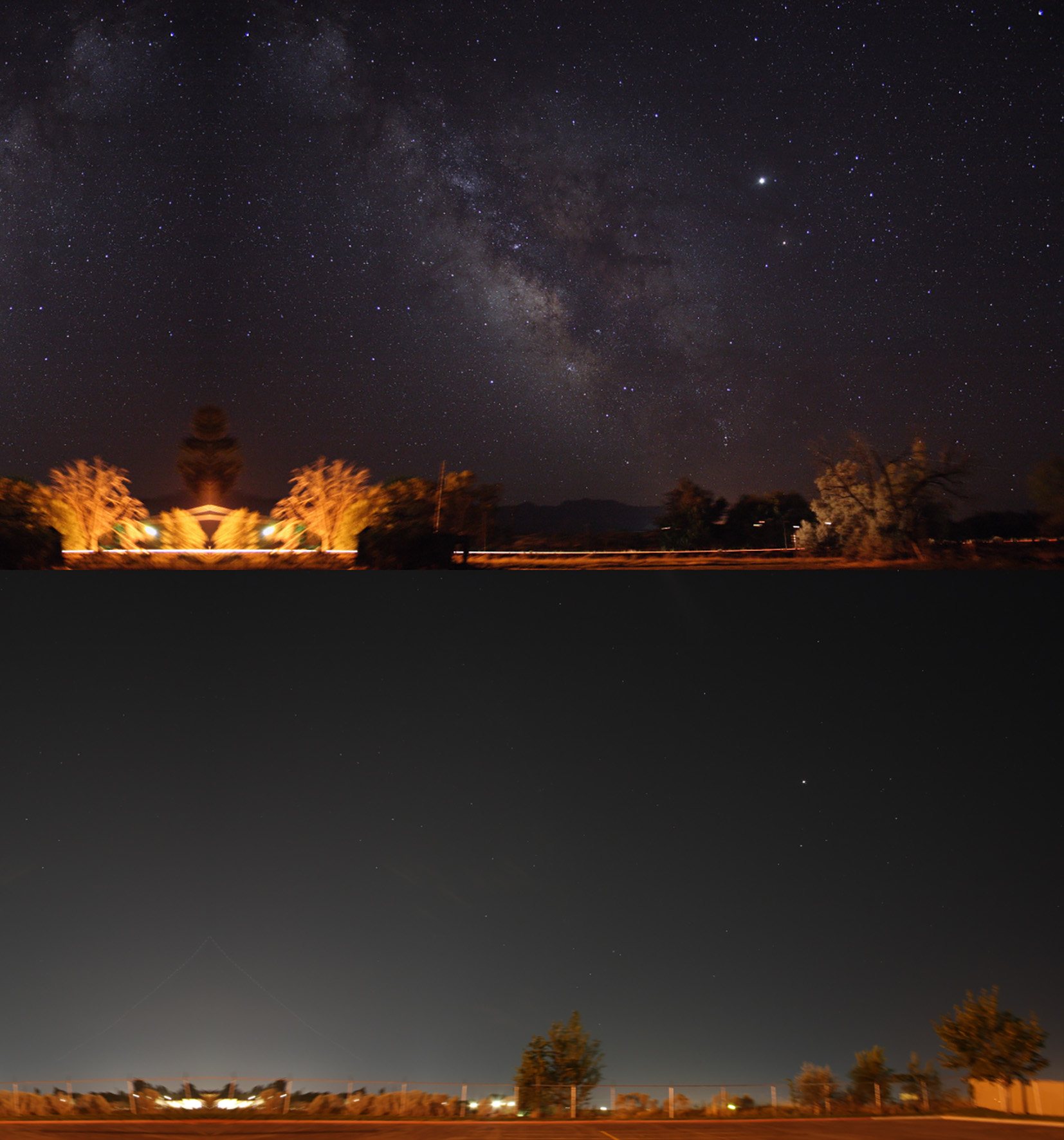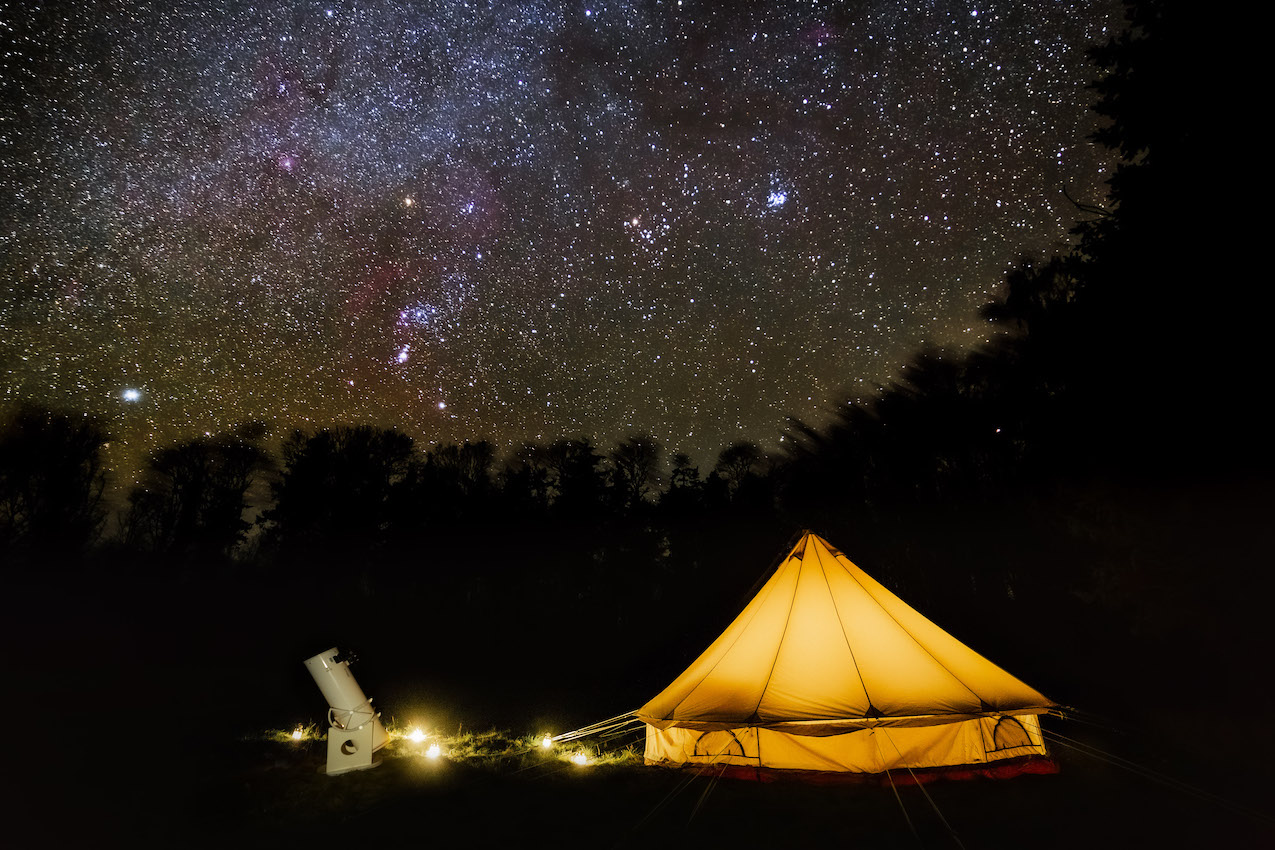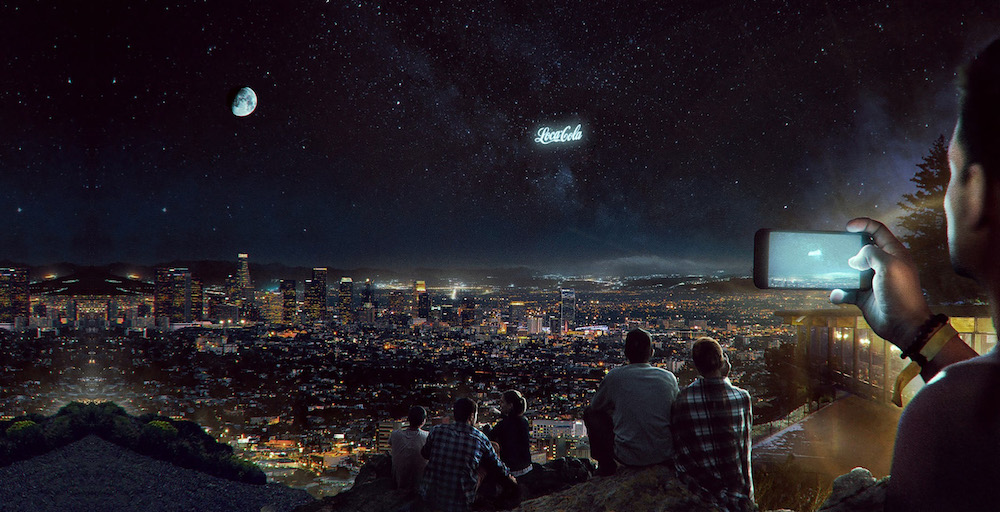With the energy crisis, superfluous lighting is being highlighted. Here and there, neon lights, illuminated displays and other useless streetlights are starting to be switched off at night and citizens' groups are forming to unplug store signs. Although experts have long identified light pollution as a major pressure on our health and biodiversity, awareness is still in its infancy. However, unlike other factors, such as climate change or soil alteration, which require solutions that are sometimes too complex to implement, fighting against this phenomenon calls for relatively simple actions following this motto: lights on only when you need it, how you need it, where you need it!
Initially developed for large cities in the seventeenth century, night lighting is a practice systematised in the recent history of our societies. The landscape of our nights has been profoundly modified with the appearance of electricity as a means of lighting public spaces in the nineteenth century. Today, when looking at satellite images of our planet, the evidence is disrupting: our Earth is bright from the sky. The most affected areas in the world are the northeastern United States between Boston and Washington, the Nile Delta, eastern China between Shanghai and Hong Kong, and several regions of Europe. In particularly, the region most concerned covers Belgium, the Netherlands and western Germany, but also the Pô plain in northern Italy, as well as central England between London and Liverpool. Luxembourg is not exempt from this observation and is also strongly impacted by light pollution.
This phenomenon keeps intensifying throughout the world. In France, for example, light pollution has increased by 90% since 1990 with an ever-increasing number of illuminated signs and streetlights. One reason to explain this global increase is the rebound effect of LED technology. Paradoxically, this new type of energy-efficient lighting has led to a multiplication of light points. Also, it is quite striking to observe the evolution of a country like India in barely four years (see below). As an illusion of man's mastery over nature, this ability to tame the night has traditionally been considered a visible marker of a country's level of development. However, the value of this all-light environment and the value of seeing just like in daylight are currently being questioned.
Evolution of lighting in India captured by satellite in 2012 (photo on top) and in 2016 (photo under).
When the lights go on, biodiversity goes off
Light is a structuring parameter of life on Earth which, as an integral part of the evolutionary process, has shaped forms of life and participated in the selection of morphological, biological and behavioral traits of living beings. Light pollution, defined as "the change of natural light levels in nocturnal landscapes by artificial lighting sources", substantially disrupts the activity of species, especially nocturnal ones. With two thirds of invertebrates and one third of vertebrates active at night, the general increase in light levels due to human activity has become a major selection pressure on biodiversity. But nocturnal species are necessary for the proper functioning of the ecosystems, mainly due to their role in pollination, plant respiration or population regulation by predators.
As explained in a Luxembourg report published by the Administration of Nature and Forests (ANF) in 2021, light impacts biodiversity in many ways.
Faced with light pollution, some species experience an increase in their mortality level. Animals with negative phototaxis, meaning that they flee light, are forced to adapt their behavior. Avoiding light obstacles can considerably lengthen their movements, exhausting them and making them more vulnerable to predators. Species with positive phototaxis, like most insects, are attracted to light. Light sources divert them from their natural path and increase the risk of mortality by exposing them to predators or by exhausting them.
Some animals also need darkness to reproduce. Thus, excessive light affects reproductive conditions, sometimes leading to local extinction of a population.
Another phenomenon described by the same report is that light pollution accelerates habitat destruction, considered to be one of the main causes of biodiversity loss. Animals with negative phototaxis depopulate lit areas, thus losing spaces that previously allowed them to survive. The lighting of roads at night leads to the fragmentation of habitats by creating an obstacle between the areas inhabited by the species and their feeding or breeding grounds. The disruption of the movement of individuals from one territory to another also has the effect of reducing genetic exchanges between populations, which increases inbreeding and condemns the species to extinction in the long term.
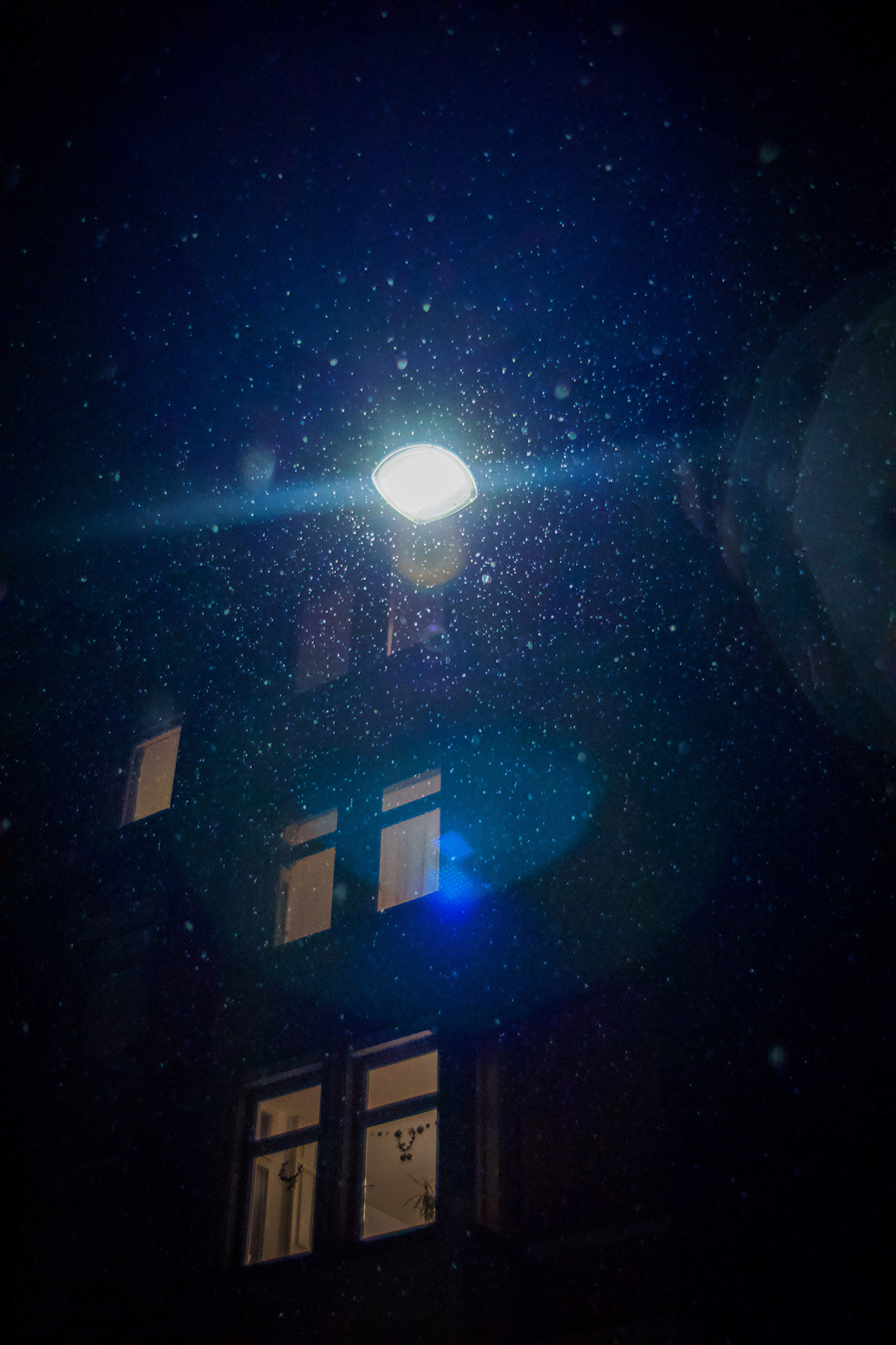
Early deaths among insects
Attracted by light, they swirl around until they are exhausted, fried by the temperature of the light sources or killed by predators. It is estimated that 150 insects die per street lamp per summer night! This represents more than one billion insects killed each night in Germany and France (data for the year 2000). The large amount of energy they spend circling around streetlights also affects their breeding conditions. Nocturnal insects are necessary for the proper functioning of ecosystems because they actively participate in the pollination of plants. However, it has recently been observed that flowers located near artificial lights are visited 62% less by night pollinators.
Disoriented birds
Birds are among those species that are heavily impacted by light pollution because vision is the sense that allows them to find their way and hunt. This loss of directional cues increases unnecessary energy consumption as well as exposure to predators. It is particularly problematic for migratory birds, as a significant portion of their flights take place at night and their orientation is determined by starlight, which is disturbed by artificial lighting. Another concern is that light blinds nocturnal birds, which increases the risk of collisions with vehicles. This is indeed the first cause of mortality for the barn owl.

Early deaths among insects
Attracted by light, they swirl around until they are exhausted, fried by the temperature of the light sources or killed by predators. It is estimated that 150 insects die per street lamp per summer night! This represents more than one billion insects killed each night in Germany and France (data for the year 2000). The large amount of energy they spend circling around streetlights also affects their breeding conditions. Nocturnal insects are necessary for the proper functioning of ecosystems because they actively participate in the pollination of plants. However, it has recently been observed that flowers located near artificial lights are visited 62% less by night pollinators.
Disoriented birds
Birds are among those species that are heavily impacted by light pollution because vision is the sense that allows them to find their way and hunt. This loss of directional cues increases unnecessary energy consumption as well as exposure to predators. It is particularly problematic for migratory birds, as a significant portion of their flights take place at night and their orientation is determined by starlight, which is disturbed by artificial lighting. Another concern is that light blinds nocturnal birds, which increases the risk of collisions with vehicles. This is indeed the first cause of mortality for the barn owl.
Unsuspected impacts on humans
The consequences of light pollution on humans are medical, economic and cultural. Paradoxically, the generalisation of lighting in cities means insecurity and accidents: surrounded by flashing luminous signs and aggressive lights, drivers and pedestrians can be blinded or distracted and thus cause accidents or become victims of them.
Furthermore, it is an undisputed fact that light disrupts our circadian cycle, our internal biological clock associated with day/night cycles, by altering the production of melatonin which is normally released in our bodies when it gets dark and suppressed when there is light. A large amount of light, especially blue light -that is, light with short wavelengths- reduces the production of melatonin, which causes health problems such as insomnia, stress and depression. It also impacts our hormonal production and cellular regulation, thus increasing the risk of cardiovascular diseases. According to Jean-Louis Duffier, professor of ophthalmology and member of the National Academy of Medicine, light pollution also increases the risk of cancer. These studies conducted on night nurses have shown a "significant increase in the risk of breast cancer. The incidence of breast cancer is 50 to 200% higher in those exposed to artificial light at night. All this is related to the inhibition of melatonin" explains the professor.
Beyond the major impacts on health, the economic impacts on humans are far from insignificant. Indeed, unnecessary lighting means a significant waste of energy. In France, for example, public lighting represents on average 41% of the electricity consumption of municipalities, or 37% of the energy bill. Depending on the energy mix, the climatic and environmental cost can be very high. According to the International Dark-Sky Association, lighting 100 white bulbs each night for a year requires the energy production of half a ton of coal. Combined with the millions of lights in our cities and in countries where energy is still mainly of fossil origin, the carbon footprint of light pollution is rather dark...
Another impact often neglected, and that astronomers and star enthusiasts have warned about for several years is the endangerment of our cultural heritage, the sky. Thousands of stars are now invisible to the human population. In cities, which are bathed in a diffuse halo of artificial light, it is rarely possible to see the stars and the Milky Way. The phenomenon is particularly widespread under the polluted skies of Europe and North America; 60% of Europeans cannot see the Milky Way. Thus, many children will only know some stars from the illustrations in their books. Let's not lose the opportunity to marvel at the night!
Photo: Evgeni Tcherkasski.
The Milky Way is invisible for one third of Humanity.
Simple solutions to solve the problem
Fighting light pollution does not require removing all lights. It means rethinking our needs and understanding how artificial lights impact the environment and our health. Mainly, we need to fight against unnecessary lighting, reduce its power, use more environmentally friendly technologies and adapt them to the context.
Roads with little traffic, company parking lots outside of the hours of use, illuminated signs and advertising... there are many buildings and infrastructures that do not need to be lit. On the other hand, it is essential that we keep the spaces used by pedestrians visible at night. Belgium, which lights all its roads, is one of the most polluted countries in Europe in this regard. However, it is possible to control the lighting time and to condition it to human activity by programming, for example, a general decrease in light intensity at a certain time of the day (after 10 p.m. or by equipping street lamps with motion detectors that trigger lighting only when the public space is used).
It is also urgent to rethink our streetlights because they are often poorly designed! The idea is to light the ground where we walk, not to diffuse the light in all directions. To protect the birds and our starry skies, the diffusion of light should not go beyond the horizontal. In this respect, light bulbs are to be avoided, preferring street lamps whose bulbs are under a shade. The height of the installations is also to be taken into account: the higher a light fixture is, the more the source produces a halo with less actual light on the zone which requires it.
It is also important to avoid reflective floors and the installation of light sources near natural reflective surfaces. Other urban designs, such as the idea of covering lit walkways with vegetation, contribute to the reduction of light pollution.
Source: Light pollution, Preserving the Night Environment for Biodiversity, ANF.
Recommendations for streetlights.
One way to improve the situation is to look at the quality of light and to adapt the light spectra to the species present on the territory. Animals are more or less affected by certain wavelengths. Short wavelengths (violet - blue) have the most harmful impact and correspond to bluish white lights such as white LEDs, which are known to interfere with our sleep cycle. Overall, narrow-spectrum bulbs, which emit in amber and white, have the most favorable spectra for biodiversity.
But sensitivity to the light spectrum varies between species. This is why lighting must be designed with knowledge of the surrounding biodiversity. For example, the sensitivity of freshwater fish to the whole light spectrum requires limiting or even completely eliminating all light sources along waterways, whereas mammals can tolerate yellow-orange lights. This is why local plans are so important; it is essential that municipalities adapt national plans to the biodiversity of their territory.
Overall, a general decrease in lighting intensity is desirable. Beyond the energy savings, preserving our sleep, the life span of the devices and protecting biodiversity are benefits that should not be neglected. Light pollution expert Andrej Mohar recommends an intensity of 10 candela per cubic meter, which is ten times less than what is usually found in many public spaces such as company parking lots, roads and residential areas.
Wavelength
Light is an electromagnetic wave. The wavelength measures the distance between two consecutive cycles of a wave. This distance is measured in nanometers (nm). The wavelength of a light gives information on its color.
Luminous intensity
The luminous intensity is a quantity that expresses the ability of a point source of light to illuminate in a given direction and is measured in candela.
Illuminance
It is the amount of light received by a surface. The illuminance depends on the light intensity, the distance of the light source to the illuminated surface and its orientation. It is measured in lux.
The color temperature
It characterizes a light source compared to an ideal material emitting light only by the effect of heat. It is measured in Kelvin.
Wavelength
Light is an electromagnetic wave. The wavelength measures the distance between two consecutive cycles of a wave. This distance is measured in nanometers (nm). The wavelength of a light gives information on its color.
Luminous intensity
The luminous intensity is a quantity that expresses the ability of a point source of light to illuminate in a given direction and is measured in candela.
Illuminance
It is the amount of light received by a surface. The illuminance depends on the light intensity, the distance of the light source to the illuminated surface and its orientation. It is measured in lux.
The color temperature
It characterizes a light source compared to an ideal material emitting light only by the effect of heat. It is measured in Kelvin.
Countries and cities blowing the wind of change
Thanks to the efforts of many dark-sky activists, the Czech Republic became a pioneer by adopting Europe's first anti-light pollution law in 2002. The text stipulates that all outdoor lighting must be equipped with a cap that prevents the diffusion of light towards the sky and imposes a 30% reduction in light intensity after midnight.
In 2007, Slovenia followed the example by passing a law based on a simple principle: "no light above the horizon". This law indicates that all lighting must be inclined to direct the light flow towards the ground, without diffusing above the horizontal and also imposes a maximum annual energy consumption for public lighting of municipalities as well as for road lighting.
In France too, laws exist. In 2009, the "Grenelle de l'Environnement" recognised the night landscape as a "heritage of the nation", and in 2018, a decree imposed strict regulations on businesses, no longer allowing them to broadcast advertising and light their windows at night between certain hours. However, it is not uncommon to encounter illuminated signs or windows lit in the middle of the night in the cities of France, thus reminding us of the importance of raising awareness in order to complement these virtuous actions. Nevertheless, the energy crisis has renewed the interest of individuals in this subject as well as that of the government, which has introduced new measures to reduce light intensity and reinstate the nighttime extinction of signs and luminous advertisements in its plan for energy sobriety. These are salutary measures in a world where the starry sky is constantly in danger.
Photo : Jeremy Stanley.
Comparison of the sky appearance from a village and from an urban area.
Did you know?
Islands that protect their stellar heritage
Mön and Nyord, two neighboring Danish islands, took the decision to become dark territories so that their inhabitants can see the Milky Way at night. Mön, a very popular destination among tourists, has even won the approval of the International Dark-Sky Association. The town has turned the lights towards the ground, banned blue lights and now uses motion sensors to light only when necessary. A dive into darkness to the delight of residents and visitors...
Will the sky business turn off the stars?
Ads popping up from the sky after dark? If the idea sounds like a bad hoax or a disturbing dystopia, the lack of regulation on the commercial exploitation of space could make the starry sky an advertising medium in the near future. On August 7, 2021, the CEO of Canadian company Geometric Energy Corporation, Samuel Reid, announced that he was partnering with SpaceX on a project to put advertising satellites into orbit to "democratise access to space." This announcement echoes the ambitions of the Russian company StarRocket which planned to launch its first swarm of nanosatellites in 2021, which, grouped in space according to the design of a company logo, would be visible from Earth. The company, of which PepsiCo is the first customer, is taking advantage of the boom in mini-satellites which, thanks to their small size of only a few dozen centimetres as well as their advantageous price, are becoming a juicy business at the expense of a universal cultural heritage. Recently, Candy Crush celebrated its 10 years by launching 500 drones over the New-York sky, advertising itself all at once and causing inhabitants’ resentment. Will the energy crisis put an end to these disastrous initiatives?
Credit: Startrocket.
Simulation of a space ad: The most iconic brand in the city sky.
To be read also in the dossier "Light Pollution"



